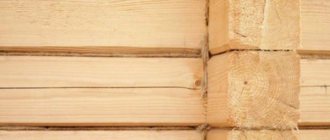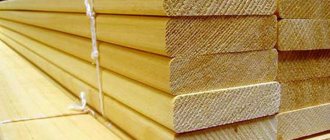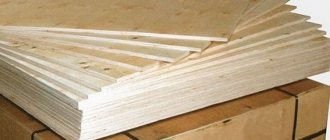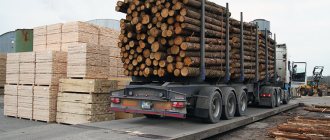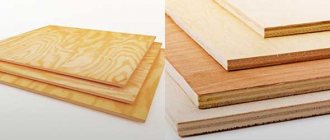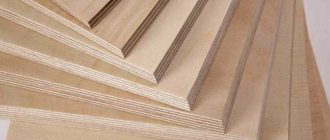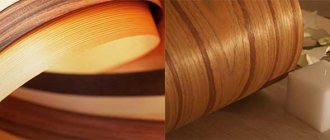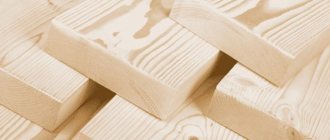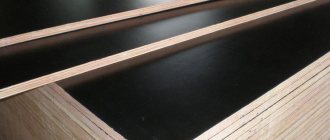Preparation of wood for plywood production
High-quality wood is used for plywood production.
The presence of significant defects—knotiness, cross-layering, and especially the presence of cracks of various origins—severely reduce the quality of the veneer and its yield. Logs intended for plywood production are cut into pieces called churak. Cutting is done on circular saws or manually with electric saws. When sawing, part of the defective wood is removed. The length of the churaks is equal to the length of the veneer that needs to be obtained. The bark and bast are removed from the churaks. This process is called debarking. To make the wood soft and reduce damage to the veneer when cutting it, it is soaked in special pools of hot water or heated in autoclaves. Industrial pools can be open or indoor. In outdoor pools, churak cooking takes place in cycles. In covered containers, raw materials are processed continuously (pass-through type of processing). Also, for steaming wood, cooking pits are sometimes used, into which hot steam is supplied.
Investment in plywood business
Of course, will vary in each specific situation. However, let's try to calculate the estimated investment.
Let's consider the option of organizing the production of FC plywood:
- For the production of cubic meters. We need 1.5-1.8 cubic meters of such material. birch trees
- The cost of raw materials will be about 2000 rubles.
- With a minimum recruitment of personnel and equipment, our workshop will produce 45-50 cubic meters. plywood for a month.
- Monthly investments in this case will be:
So, we examined in detail the production of plywood: production stages, requirements for raw materials and products, and also compiled an approximate price list for the cost of equipment.
In general, with an average production load, the payback for such an enterprise is at least 1.5 years. Don't forget that funds to start production of the material can be obtained from an interested sponsor. The main thing is to provide him with a clear financial plan for the development of the enterprise, drawn up with a professional economist.
What types of plywood are there?
The entrepreneur has to decide what type of building material he will produce:
| Construction | Manufactured using highly water-resistant adhesives of the FSF and FK brands. It can be either polished or unpolished. Construction plywood is produced mainly in large sheets measuring 2440 by 1220 mm, with a thickness of 8 to 19 mm. Intended for the construction of prefabricated panel, frame and mobile structures, used in carriage building and for the construction of wooden houses. |
| Aviation | It is made from thin, high-quality birch veneer and is used for the manufacture of light aircraft and musical instruments. |
| Bakelized | It is made by gluing sheets of birch peeled veneer with mutually perpendicular direction of the fibers in adjacent layers of phenol-formaldehyde resins. There are different brands, depending on the glue used and the method of its application: FSB, FBS1 (outer layers are impregnated with alcohol-soluble resin), FBV and FBV1 (outer layers are impregnated with water-soluble resin, and alcohol-soluble resin is applied to the inner layers). Produced under high pressure and has high strength. |
What is pressed plywood?
This material is produced in the form of large sheets. It is produced by joining several sheets of veneer. The fibers of adjacent layers must be mutually perpendicular.
Birch veneer is mainly used for production, but any other wood can be used. Along with ordinary plywood, special types are also produced, which have much higher resistance to torsion and bending.
Special types also mean plywood that acquires unique properties through the use of a certain technology. These materials include large-format and bakelite plywood, as well as not very commonly used types of sheets - with metal and fiberglass cladding, and cork chips. And also reinforced, composite, bioresistant, textured or electrothermal.
Areas of application of plywood
This is a universal material that is used both in professional environments and in households. Perhaps the largest volumes of plywood are consumed in construction and furniture production. At home, such sheets can be used in interior design, room decoration and household needs. Industrial production of plywood with improved technical and physical qualities allows us to offer worthy products for the automotive and railcar industry. Again, the popularity of this material is due to its low cost and decent performance properties. Plywood is not as durable compared to metal and fiberglass, but it is more attractive compared to wood-based products. The only serious limitation on the use of such sheets is the presence of chemically unsafe adhesive mixtures in the structure. That is, we are not talking about environmental cleanliness either.
Plywood production
Plywood is a high-quality building material that has many layers; it is also called wood-laminated board.
Plywood is made from veneer, the number of layers of which is most often not even, that is, three or more layers.
In order to create a very durable material, layers of veneer are placed on top of each other strictly perpendicularly, so that the layers of wood adhere to each other as much as possible.
Areas of application:
- in construction;
- for insulating products in electrical engineering;
- in various aviation industries;
- for furniture production (chipboard);
- in shipbuilding.
Equipment for plywood production
The production of raw materials, like plywood itself, is a high-tech process. And the equipment that is used in such production must be of very high quality and high-tech. It should also be noted that specialists and workers in such complex production must be qualified specialists.
High-quality equipment for the production of plywood can provide the ability to produce and produce high-quality and durable products that satisfy consumer demand in the building materials market.
If we talk more precisely about the necessary equipment for production, then it is worth noting that the amount of equipment for production is very large and varied.
Required equipment includes:
- various machines, both for processing veneer and for final processing of plywood sheets;
- equipment for applying glue and gluing finished veneer sheets;
- equipment for initially foaming the adhesive suspension;
- glue application machine;
- mechanism for clear and correct laying of sheets;
- mechanism for feeding veneer and plywood sheets to the processing line;
- near-press mechanism;
- grinding machines;
- crushing machine;
- waste machine.
As a result, it is worth saying that even the manufacture of this equipment is a rather difficult process, and the manufacture of veneer and plywood is even more so.
Plywood production technology
Initially, the resulting logs are divided into churaki. The length of the churaks is usually approximately equal to the length of the future veneer, from which the plywood sheets are folded.
Churaks are cut on special machines and steamed in special containers designed for this purpose with hot water in order to give the churaks elasticity and softness.
Hot water is used to prevent the wood from splitting or breaking.
To make high-quality plywood, use veneer with a moisture content of no more than 6%. To obtain veneer of such moisture content, it is dried well in various special devices, and after that it is divided into different grades, according to the principle of the presence of knots, shoots that were not removed during processing and other various defects.
In order to qualitatively improve the grade of manufactured and processed veneer, normalization of veneer dimensions is required. To do this, some veneer sheets are processed manually, that is, various defects, knots, shoots are cut out, and sealed with veneer patches that level the sheet and increase its quality and grade. All this is done using various machines.
After these manipulations and quality control, the veneer requires processing and conditioning, and only after all this does it enter the workshop that glues the sheets together to create plywood.
Next, the finished plywood is placed in packaging bags and transported.
After the plywood has been processed and glued on machines, before being packaged, it is processed on circular saws, which trim the excess portions of the finished plywood sheets to the required size.
The best grades are ground and processed on a special grinding machine or other available equipment. Plywood that can be sanded has greater strength and wear resistance, and is also less susceptible to various mechanical and technical damage. Such finished plywood is called calibrated.
After all these treatments and sanding, the plywood is packaged and labeled for shipment and delivery to the customer.
Bakelite plywood
It turns out that you can make something even more durable from ordinary wood! For example, wood-laminated plastic. It is called bakelite plywood. Or delta wood. It is so strong that it can replace bronze. Sliding bearings and silent gears are made from bakelite plywood. Delta wood resists any type of deformation, does not chip, break or stretch. Wood becomes as durable as non-ferrous metals thanks to bakelite varnish. It makes the material almost invulnerable. It can even be used underwater. Regular birch veneer is varnished on both sides and sent to the dryer. Here, at a temperature of 100 degrees, it is completely absorbed into the wood. That is, in wood plastic, every sheet of veneer is impregnated with varnish. The layers are separated by metal sheets and sent under a press. He spends hours compressing delta wood at 6 times the pressure of regular plywood. The number of layers of wood plastic reaches hundreds. Fuselages and wings of aircraft were made from lightweight and ultra-strong delta wood. Among them are the first all-wooden Soviet fighter, nicknamed “Royal,” and a German air-to-air missile from the 3rd Reich.
Plywood production in stages
The first step in production is the primary processing of wood (usually from coniferous trees), which must be measured and cut into bars. The wood is exposed to steam or placed in a pool of warm water (approximately 40 degrees Celsius). This increases the ductility of the material.
The second stage is removing the bark from the wood. The bark is a by-product of the manufacturing process, but it is usually ground up and pressed into chipboard.
The third manufacturing step is sawing into pieces 1.3 to 1.6 m long. They are called “churaks”.
The fourth stage of production is circular sawing of the block according to its diameter. The result is a sheet of wood called “veneer”. The veneer is cut to the required size and dried in piles under the influence of a stream of warm air.
The process of peeling birch veneer at a plywood manufacturing plant.
The fifth stage in the manufacture of the material is checking the drying of the veneer. This is a necessary step because raw wood cannot be used to make plywood. Raw sheets are disposed of or sent for re-drying with warm air. The veneers are pressed, sanded and sent to the next stage of processing.
The sixth step - strips of wood are glued into sheets, which are later cut to the required sizes and laminated.
Final work: sorting, finishing the edges of the material and packaging.
List of requirements that must be taken into account when producing the material.
| 1. | To make the outer layers of plywood, hardwood veneer is used: birch, alder, maple, elm, beech, aspen, poplar, linden. For the inner layers, in addition to those mentioned, coniferous veneers are also used: pine, spruce, fir, larch and cedar. |
| 2. | Veneer inserts must fit the surface, adhere firmly and match the grain direction of the wood of the outer layer of plywood. For grade II, the inserts must match the color of the wood. |
| 3. | |
| 4. | Putties must be selected according to the color of the wood of a given type, ensure adhesion of facing materials, do not crumble during mechanical processing and bending of plywood, and do not crack. |
| 5. | Plywood must be formed into packages weighing no more than 1500 kg separately by species, grade, grade, emission class, type of surface treatment and size. |
| 6. | The quality and dimensions of plywood sheets are checked by random inspection. It is allowed, by agreement between the manufacturer and the consumer, to carry out continuous inspection. |
| 7. | The tensile strength when chipping along the adhesive layer, the tensile strength during static bending of the fibers of the outer layers, the tensile strength along the fibers are monitored for each brand, thickness and ply layer at least once a month. Control is allowed for each batch by agreement between the manufacturer and the consumer. For this, 0.1% of the sheets from the batch are selected, but not less than one sheet. |
| 8. | The length and width of plywood are measured at two points parallel to the edges at a distance of at least 100 mm with a metal tape according to GOST 7502 with an error of 1 mm. The actual length (width) of the sheet is taken as the arithmetic mean of the results of two measurements. The thickness is measured at a distance of at least 25 mm from the edges and in the middle of each side of the sheet using a thickness gauge according to GOST 11358 or a micrometer according to GOST 6507 with a division value of no more than 0.1 mm. |
The production of building materials is regulated by GOST 3916.1-96
What is plywood made from?
The raw material for production is deciduous and coniferous wood of various species. The most preferred is birch, which is characterized by low knots, low density and an easy-to-process arrangement of annual rings. More viscous and heavier species (oak, beech) are used less frequently, since they require significant costs to restore the inevitable defective areas.
Plywood consists of planes of thin veneer glued together layer by layer, obtained by unraveling logs rounded and freed from bark. The intermediate layers are coated with synthetic or natural adhesives that provide the specified strength and moisture resistance of the material.
Most adhesives in a dry state are safe for humans, with the exception of certain phenolic and formaldehyde compositions. An adhesive base of natural origin (casein) can be used in the manufacture of floors and coatings for interior decoration of residential premises.
Help
If the article is read by specialists, then more in-depth knowledge about plywood manufacturing can be obtained from me if you seek advice.
In addition, I can organize the supply of equipment and sell your equipment.
Often plywood manufacturers install their own resin production facility in their production. This allows you to reduce the cost of resin by 3 - 6 rubles. I wrote in my new book how to organize all this, gave very detailed information on how to weld the resin and what equipment is needed for this. The resin is suitable for both plywood and other wood boards and even sawdust timber. Read more about the book in the “BOOKS” section.
Good luck and see you again!
Production in Russia
The main mills producing plywood are located in forest-rich regions.
The largest manufacturers of plywood products are:
- “Zheshart Plywood Mill” is a post-war enterprise that initially provided the production of aircraft plywood;
- Syktyvkar Plywood Plant LLC - specializes in the production of furniture products and large-format plywood boards;
- TK Plitprom LLC - offers a wide range of rough and finished furniture materials (countertops, parts, fittings, etc.);
- plant "Fankom" - produces plywood and sells woodworking equipment;
- OJSC Seletsky DOK is one of the oldest plants, founded in 1915. The plant’s product range includes plywood and fiber boards, which together form the basis of furniture production.
Plywood manufacturing technology
As is already clear from the above, the technology for manufacturing plywood at a factory consists of several stages. Let's take a closer look at how plywood is made at the factory.
- Primary preparation of logs. Raw materials are selected to make plywood. Selection standards are fixed in GOST 9462-88. The logs delivered to the wood processing plant are debarked, cut to the required length - depending on the specified sheet width, then soaked in hot water for some time - hydrothermally treated.
- Peeling. The prepared logs are cut into thin sheets of veneer using a peeling machine. The thickness of the veneer plates is 1.5-1.8 mm. The operating principle of a peeling machine is identical to that of a pencil sharpener. Only the blade in the sharpener is fixed at an angle, and in the peeling machine - straight. The blade of the machine is installed tangentially to the growth rings of the log. By the way, our compatriot is also the inventor of the peeling machine. Professor Fisher invented it in 1819.
- Slicing, sorting, mending. The resulting veneer is cut into sheets of a certain size. Next, the resulting veneer is sorted. Not only solid sheets of veneer are used. Plates with a width of at least 490 mm are suitable for production. Non-solid pieces are glued together using edge gluing. The sheets repaired in this way are used to make the inner layers of a plywood sheet.
- Drying. The sorted sheets are dried in a special chamber.
- Gluing. The finished sheets are glued together, and the veneer plates are positioned so that the wood fibers of the next layer are perpendicular to the wood fibers of the previous one. This method gives the plywood sheet strength. The number of layers depends on the given sheet thickness. For gluing, an adhesive composition is used, the recipe of which is kept secret by each manufacturer. Veneer plates with applied glue are collected in bags, then the cold pressing stage occurs. After this, the sheets are subjected to further hot pressing.
- Trimming and marking. The finished sheets are cut to size, sorted and labeled depending on the variety and brand.
Types and brands of plywood
Plywood is made from coniferous and birch wood. Birch plywood is more durable, but also more expensive. Therefore, materials for general consumption, for example, in construction, are most often made from coniferous wood.
There are standards for the production of five grades of plywood. Grade E – elite. It does not allow any defects on the front surfaces. The remaining grades - from I to IV - allow various defects of the sheet surface: the presence of knots, including fallen ones, cracks, wormholes, warping, etc.
https://youtube.com/watch?v=4NoSYIGcLGw
This is, in general terms, what the plywood manufacturing process looks like. In the video you can learn more about how plywood is made from birch or other wood.
How to make plywood
Production technology includes many processes, so you won’t be able to achieve a high-quality result at home. But you can do veneering of interior items or crafts with your own hands.
Equipment
To produce sheet products, production must have appropriate technical equipment with conveyor lines. Veneer selection and processing are carried out manually.
Necessary equipment:
- Sizing and debarking machine. Used for cleaning logs. A trimming device is additionally included in the line. The technology allows the use of various modifications with baths for washing and softening.
- Special installation for peeling. The most popular are automatic machines equipped with double telescopic spindles, between which the workpiece is fixed. The process is controlled until the desired result is obtained. Setting up the equipment allows you to obtain veneer of different thicknesses.
- Guillotine or special knives. They are responsible for cutting the resulting tape to the required length. Modern units perform the work independently, placing the peeled material in piles.
- Dryer. Provides the required level of humidity without disturbing the structure. The most commonly used device is a tunnel type.
At the initial stage, the quality of the resulting veneer depends on the machine responsible for peeling the wood and the drying line
- Complete installation for preparing and applying glue. The modification depends on the type of composition.
- Machines for sequential gluing of layers. The technological section includes equipment for initial formatting.
- Cold and hot press.
- Machines for processing length and width.
- Grinding and processing devices. Allows you to obtain a certain type of plates (for example, perforated products).
The installation for applying glue and the press are responsible for the solidity of the product, and the presentation of the plywood directly depends on the quality of cutting and sanding.
Only high-quality and properly configured equipment ensures the production of plywood that will meet all GOST standards and the needs of the buyer.
Manufacturing process
Algorithm of actions:
- The raw materials are fed to the sizing and cleaning line, where knots are removed from the logs and the bark is separated. The material is cut into pieces of the required size.
- The resulting lumps are placed in a bath of hot water. Additional components may be added to the liquid to maintain or improve certain properties. This step is necessary to ensure that all the wood has the same moisture content. The process also greatly facilitates further processing.
- The logs are placed on the peeler and fixed between two shafts, which set the rate of rotation. The blades located on the edge remove the veneer. Other methods can be used, but peeling is the most effective.
- Sheet or strip veneer is placed on a cutting machine, where the size is formed. For these purposes, you can use a guillotine or specially configured knives, depending on the supply of raw materials.
- The drying stage begins: moving along the roller system, the material is successively processed with hot air. The result should be products with a residual moisture content of 4–6%.
- The veneer is fed to the inspection area, where defects are eliminated and sorted. Although the production line is as automated as possible, some work must be done manually. Raw materials are distributed by size, pre-cleaned and grouped into piles.
- A gluing mixture is applied to the core material, and the top is lined with perpendicular layers. If it is necessary to strengthen the structure of the slab, then additional layers are added.
- The formed sheets are placed on the pressing area. Depending on the glue used, the cold or hot method is used. The first option involves compressing the layers for 6 hours at a constant temperature, the second involves the use of high pressure and a hot press.
In almost all factories, the layout of the line for the production of plywood sheets is the same, and the quality of the final product depends on the technological level of the equipment that makes up the conveyor.
After this, final processing is carried out, which makes it possible to obtain the material with the required degree of finishing: sanding, lamination, coating with various decorative compositions.
Attention! The cost of plywood depends on the method of pressing and processing.
Veneer drying
For this procedure, a special conveyor is used, on which the lamellas are exposed to warm air currents. Using measuring devices such as a moisture meter, the line operator monitors and sorts the veneer. According to technology, the optimal moisture content of lamellas for plywood production should be 6%. Excessively wet sheets after heat treatment are either sent for drying or rejected. Since the lamellas have a very delicate thin structure, mechanical defects are often encountered. But if there is minor damage, the veneer is not discarded. At this stage, it is possible to repair plywood sheets using artificial inserts of fragments of new veneer, which is selected according to texture, moisture content and size. The lamellas that successfully pass this stage are checked by a scanner and sent for daily storage.
From the depths of history
As often happens with history, it gets worn out from prolonged use, and now it is no longer possible to discern the details, and only very salient facts are visible.
The name "plywood" comes from the Dutch word "fineer", which means a thin sheet of wood, veneer. But thin wood sheets glued together into a single three or more layered sheet were called arborite.
Thin sheets of wood - veneer - have been known for a very long time. Scientists believe that the most ancient product with a veneered coating is a box-casket found in one of the pharaoh’s tombs. The chest is made of cedar wood, and on the front side it is covered with thin plates of ebony. This was done, most likely, to reduce the cost of the product - Egypt had, to put it mildly, not enough of its own forests, and wood was imported from afar.
Mass production of veneered furniture began in France in the 16th century. This imitation of valuable wood species in furniture production has made it possible to make furniture more accessible to the mass consumer. It is from the carpentry technology of veneering that the slang name for the use of plus phonogram by some performers comes from: “singing to veneer” - imitating for the mass consumer a valuable live performance with a pre-recorded phonogram.
But let’s return to the material glued together from several sheets of plywood - arborite. This technology was invented in 1881 by Ogneslav Stepanovich. Kostovich. Kostovich developed a new material for the manufacture of parts of the Rossiya airship. Not only the skeleton of the airship was made from arborite, but also engine parts, including the transmission shaft, which was thirty meters long.
Gluing lamellas
Special compounds, sometimes with unique recipes, are used as glue. Each plant strives to develop its own methods for producing an adhesive mixture that will distinguish a sheet of plywood from the crowd of competitors. For example, some compositions already inside the structure provide the effect of lamination with phenol-formaldehyde resins. But more often it is practiced to produce laminated plywood with the application of a paper-resin film, which makes the material stronger and more resistant to moisture absorption.
The application of the binder is carried out on special machines using corrugated cylindrical drums. The lamellas, treated with glue, are sent to the assembly, where veneer packages are formed. Here the sheets are subjected to cold pressing, which is a preparatory stage before final gluing. The sheets are brought together perpendicular to each other. The basic gluing procedure uses a hydraulic hot press supported by mechanical loading. The finished plywood sheets are kept for 24 hours in the workshop conditions.
crazy hands
Can ordinary plywood be produced in a small private workshop? For the full cycle - hardly; oversized equipment is required for steaming, debarking trunks and peeling veneer. But gluing veneer into finished sheets at home is quite possible.
Why is this necessary? For example, for the production of so-called engineered parquet boards, consisting of FC plywood with a layer of hardwood veneer glued onto it.
The most obvious way to set up handicraft production is to buy glue rollers and a press, since used equipment for the production of plywood is quite affordable. However, if you produce plywood yourself not for sale, but solely for the sake of repairs in your own home, it simply will not pay off.
Plan “B” consists of cold gluing the veneer to the finished plywood sheet:
Pasting plywood with noble wood veneer.
- Both the sheet laid on a flat base and the back side of the veneer are coated with PVA glue;
- The veneer is laid on the surface of the sheet and smoothed;
- The workpiece is pressed down with a sheet of thick (22 - 27 mm) plywood and loaded with a weight of 300 - 400 kg, distributed as evenly as possible over the entire surface.
It will take about a day for the glue to dry completely. After this time, the sheet is cut into boards of the required size using a regular stationary circular saw. A router or hand-held wood router with a guide is then used to chamfer about a millimeter deep.
The appearance of the resulting material will not be inferior to purchased parquet.
Please note: for obvious reasons, parquet made in this way can only be laid with glue. In the absence of click locks, there is no talk of floating installation.
Equipment for plywood production
Equipment for plywood production is not cheap.
You can verify this by studying the price table for the main components of the production line:
| № | Equipment name | Picture | Description of equipment | Approximate cost, rub. |
| Total: | 3,540,000 rubles | |||
| 1. | Peeling machine | The equipment is used to remove the first layer of veneer. The presence of a debarker ensures high quality of the initial processing of the block. With the help of a good cutter, the workpiece is given the correct shape. The presence of a flexible corrugated hose allows for worry-free removal of waste during operation. | From 170,000 | |
| 2. | Dividing machine | Using this equipment, the veneer strip is divided into individual planks or sheets of the required width. The width of the sheet is set using a special electronic device. This equipment must be used on the same line with a veneer production machine. The width of the processed veneer can be up to 1600 millimeters. | From 1,120,000 | |
| 3. | Calibrating machine | The equipment is produced on the basis of trestle-type machines. The presence of a high-speed drive allows you to control the speed of the machine. Convenience when working on the machine is provided by the possibility of automatic table control. Thanks to this unit, the surface of the plate is calibrated. | From 650,000 | |
| 4. | Plywood press | The base of the equipment is made of cast steel or welded from beams of the appropriate profile. From one to eight hydraulic cylinders with a diameter of 200-650 mm are built into the base in various presses. Heating plates are made with a thickness of 38-50 mm for the production of plywood. | From 1,600,000 |
To work on the equipment, you need to hire several general workers, as well as a technologist who will monitor the process. Don’t forget about an accountant - it will be extremely difficult to manage without one.
Plywood production technology. What are the stages of the process?
Necessary equipment. Application of plywood.
General manufacturing technology
Plywood sheet is a type of heterogeneous wood material. Only thin-leaf veneer is used as a base, layered on top of each other under high press pressure. Actually, the whole process can be divided into three main stages - preparation of wood, its processing and gluing. Also, different production facilities may include additional stages that improve or modify certain qualities of blanks or finished products. For example, modern plywood manufacturing technologies provide for repeated impregnation of the veneer structure in order to give it fire-resistant and frost-resistant qualities.
This is especially important if plywood is subsequently used in roof construction. After the production of this material, a lot of waste also remains (mainly after peeling), which can be consumed in the process of manufacturing particle boards
Stages of production and technological process of plywood manufacturing
With minor upgrades to the equipment and gluing components, the manufacturing process itself and the steps taken to produce plywood as a finished product have remained virtually unchanged since the 19th century, when it was first developed.
Stages preceding the receipt of finished products:
- Harvesting of timber (initial logs with the required parameters);
- Pre-treatment - removing bark, growths and knots, giving the log a rounded shape and treating the wood with steam in hot water to reduce the internal stress of the trunk;
- Peeling of veneer – obtaining a thin (from 0.5 to 3 millimeters) and long strip;
- Edge processing, repair and drying of veneer;
- Multilayer composition of veneer with the application of glue on the plane of the workpiece. The sheets are laid in such a way that the fibers of each sheet subsequent to the first layer are perpendicular to it;
- The process of processing by pressing, drying in chambers and final processing of plywood blanks - edge cutting.
You can see the production of FSF laminated plywood in more detail in the video:
Technological characteristics and types of plywood sheets
Plywood production technology offers several types and grades of finished products, differing in type of processing, moisture resistance and grades. According to water-repellent characteristics, these are:
- FC - plywood with low resistance to moisture and recommended for use for interior construction work and finishing;
- FSF is plywood in which compounds based on phenol and formaldehyde were used for gluing veneer. It has better moisture resistance compared to FC and can be used for outdoor work. But due to its chemical components in the adhesive composition, it is not intended for rooms with constant presence of people.
- FB – specialized plywood for climates and rooms with very high moisture content (tropical climate, swimming pools, baths, etc.);
- FOF is a sheet of plywood laminated on 1 or 2 sides with special paper or film.
According to the quality of the processed surface:
- polished on 1 side (w1).
- on 2 sides (w2).
- plywood with non-sanded surfaces (nsh).
The number of grades is determined by 4 categories, depending on sheet defects (knots, manufacturing defects).
A special case
To avoid confusion in terminology, it is worth explaining one subtlety. Contrary to its name, perforated plywood has nothing to do with veneer laminate.
This is the name of an HDF sheet (high-density fiberboard, also known as pressed hardboard) with holes made in it at regular intervals. The material is used in the design of shop windows, as panels for cabinet and interior doors, etc.
Perforated HDF.

